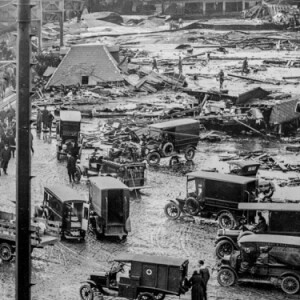A Sticky Boston Anniversary
106 Years Ago Today, the Great Molasses Flood Sent Sticky Waves of Syrup Crashing Through Boston
As the locals say, you can still smell the scent of molasses on a hot summer day.
Info taken from and article by Merlyn Miller...
You might be familiar with the Boston Tea Party, but for many Bostonians, there’s another food-centric event that comes to mind as they reflect on local history: the Great Molasses Flood.
A surge of sticky dark brown syrup washed over Boston’s North End on January 15th, 1919, it wreaked havoc on the neighborhood, killing 21 people, injuring 150, and destroying businesses and homes.
To start understanding the Great Molasses Flood, you need to first grasp exactly how much molasses was involved. A 50-foot-tall tank, 19 feet in diameter, full of 2.3 million gallons of molasses broke open on January 15th. The wave of viscous liquid that was released reached up to 40 feet at its highest points, and traveled through the streets at 35 miles per hour. A wave of water at these heights and speeds would undoubtedly be dangerous, but molasses is denser — and consequently heavier — than water, making it even more difficult to move through.
Stephen Puleo, historian and author of Dark Tide: The Great Boston Molasses Flood of 1919, says to “think of the wave as a small tidal wave that disgorged from the tank when it disintegrated, recoiled off of the back side of Copp's Hill, and then traveled southward along Commercial Street, scouring everything in its path: people, horses, houses, carts, produce and supplies that [people delivered] to the waterfront... and debris of all sorts. It's this debris like wood, bricks, stone, etc. that caused many of the serious injuries.”
The molasses was so strong that, according to Puleo, “The overhead train trestle for the Boston Elevated Railway that connected the north station with the south station was severed and damaged by the molasses wave and pieces of the tank. A train traveling overhead barely missed plunging to the street below.”
Firefighters, police, and sailors were quickly on the scene to help rescue those trapped by molasses, collapsed buildings, and other debris. Because the flood occurred in January, the molasses became thicker as the day grew later, and the syrup gradually chilled, making it more difficult to free anyone stuck in the liquid. Puleo notes that the liquid was thick enough that “Firefighters laid ladders horizontally across the molasses and crawled on them to pull victims out.” Some descriptions of rescue efforts detail how people were dug out of the molasses, emphasizing its tackiness.
The Great Molasses Flood was, unfortunately, a very preventable disaster. The tank holding the syrup — which was owned by the United States Industrial Alcohol Company (USIA), with the intention of fermenting the molasses into industrial alcohol for the production of munitions — was shoddily constructed from the beginning. Its walls were too thin to reliably hold the weight of all the molasses, and observers nearby could reportedly hear groaning sounds each time it was filled.
Even after any rescue efforts had been exhausted, cleaning up millions of gallons of molasses was a monumental task, and Bostonians said for decades following the flood that they could smell the aroma of molasses during the hot summer months. That lingering scent mimics the way the events of January 15, 1919 have stayed on local’s minds.
The flood is the perfect storm of peculiar (it was a wave of molasses after all), and also tragic. Together those two factors inevitably spark intrigue, and ensure that the events from 106 years ago today won't be forgotten. Students at Harvard have studied the physics of the flood, and why the tank burst. There’s a children’s book that many locals may recall reading while growing up. If you're visiting Boston, you can even take a tour to learn more about the historic tragedy. "
https://apple.news/AYJ_7aPDWTcCO_SfPRRQ9Zw
When I read about this today, I thought it might make an interesting blip and I know of a local connection as well. A good friend's grandfather was driving his team of horse in the area and was thrown into the flood, the horses perished, he was rescued with a broken back and became disabled enough that he had a very hard time working to support his eleven children. He is mentioned in the book, Dark Tide.
The extra is from the article.
For the Record,
This day came in sunny and cold.
All hands thinking of California


Comments
Sign in or get an account to comment.


